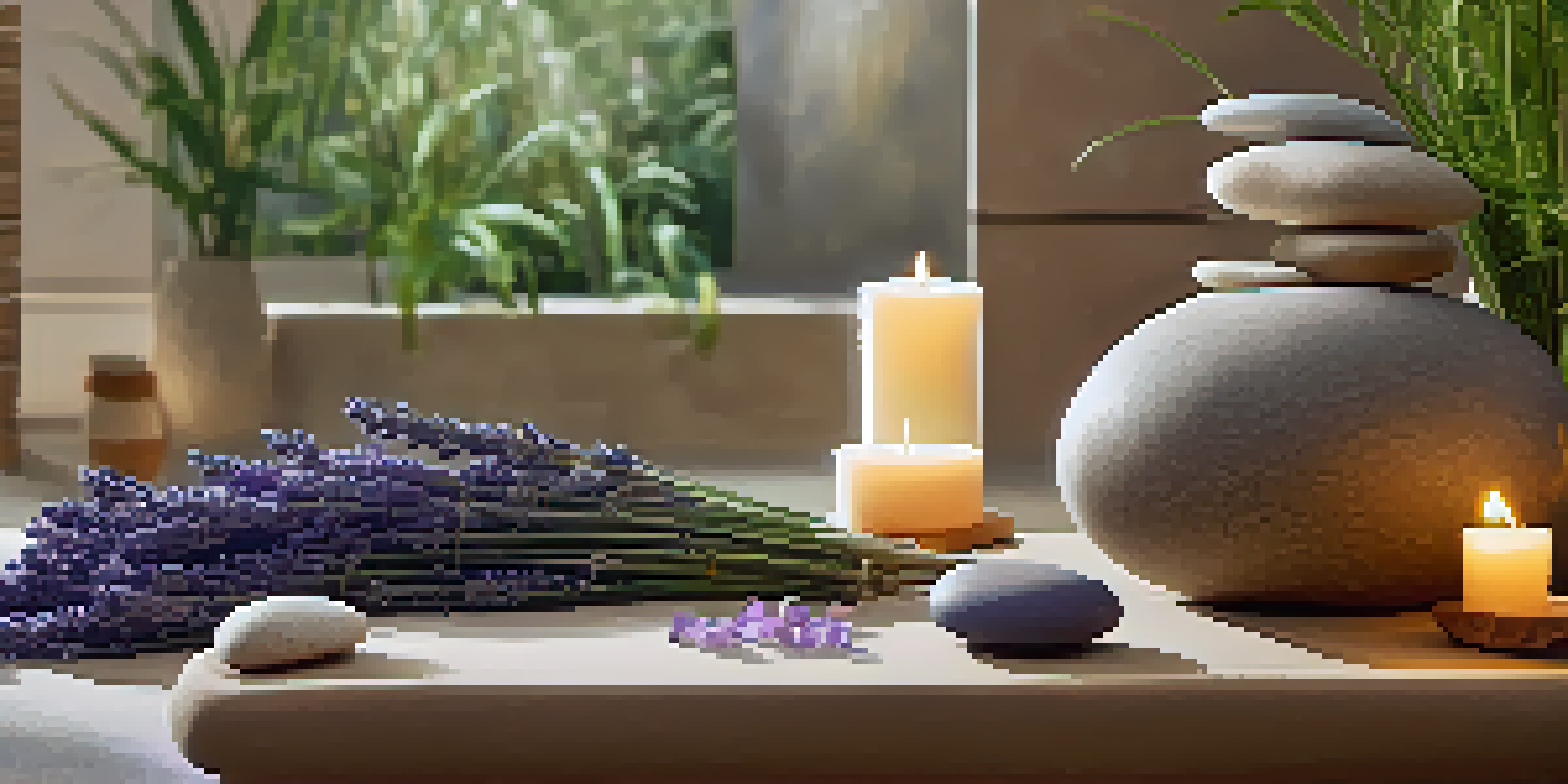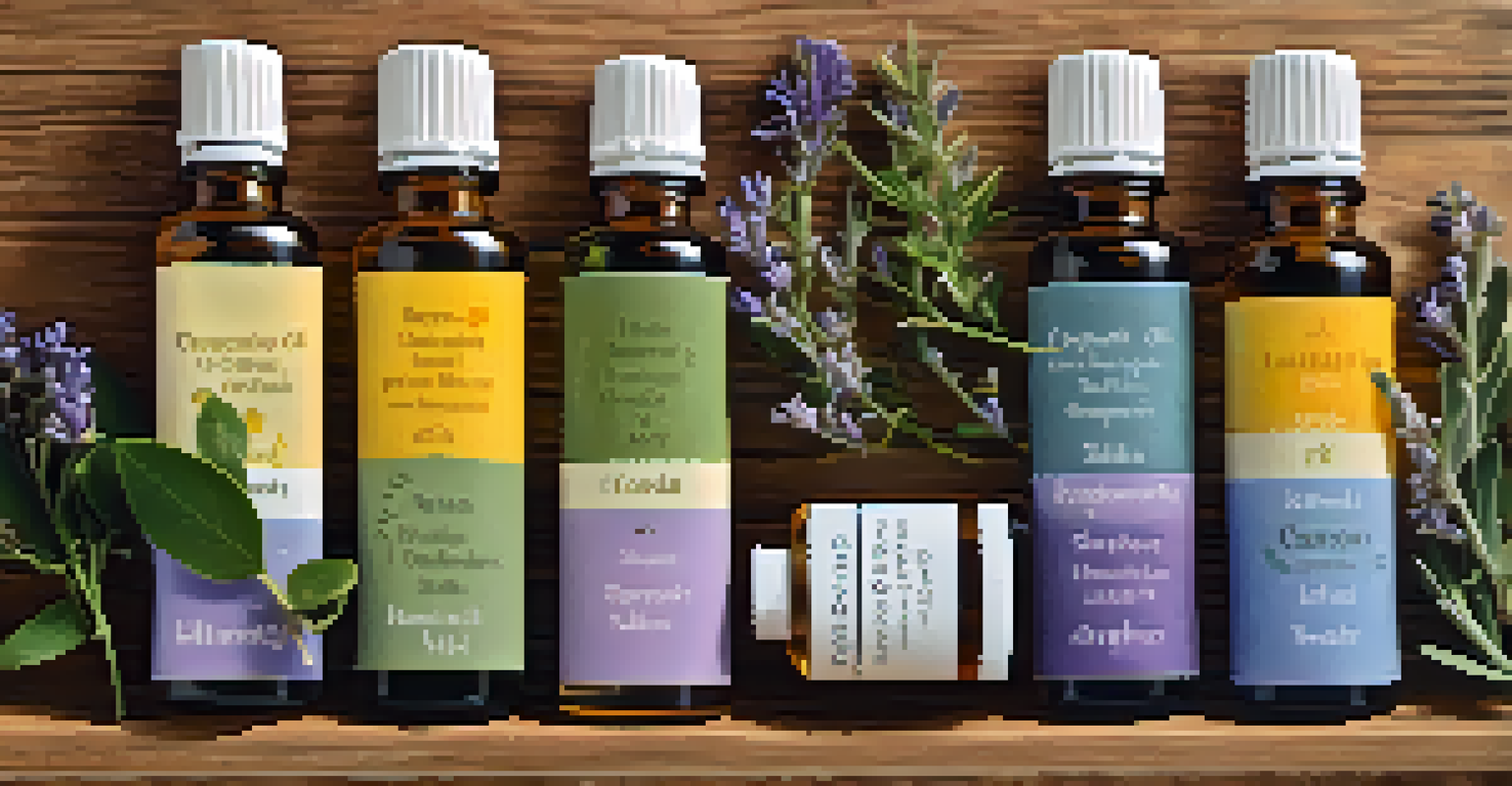The Use of Aromatherapy in Spa Treatments for Stress Relief

What is Aromatherapy and How Does it Work?
Aromatherapy is a holistic healing practice that uses essential oils extracted from plants to promote physical and emotional well-being. The process involves inhaling these oils or applying them topically, allowing the aromatic compounds to interact with the brain's limbic system. This part of the brain is responsible for emotions, making aromatherapy a powerful tool for stress relief.
Aromatherapy is a holistic healing practice that uses essential oils extracted from plants to promote physical and emotional well-being.
In a spa setting, aromatherapy can be seamlessly integrated into various treatments, such as massages or facials. For instance, lavender oil is commonly used for its calming properties, helping to soothe the mind and reduce anxiety. The gentle scents can create a tranquil environment that enhances relaxation and the overall spa experience.
Moreover, each essential oil carries unique benefits—like eucalyptus for respiratory support or citrus oils for uplifting moods. By choosing the right oils, spa professionals can tailor treatments to meet individual client needs, making aromatherapy a versatile approach to stress management.
Benefits of Using Aromatherapy in Spa Treatments
Incorporating aromatherapy into spa treatments offers numerous benefits, primarily targeting stress relief and relaxation. The soothing scents can lower cortisol levels, the hormone associated with stress, leading to a more peaceful state of mind. Clients often leave feeling lighter and more rejuvenated after experiencing the calming effects of essential oils.

Additionally, aromatherapy can improve the overall spa experience by engaging the senses. The pleasant aromas create an inviting atmosphere, making clients feel more comfortable and open to relaxation. This sensory engagement not only enhances the treatment but also fosters a deeper connection between the client and the spa environment.
Aromatherapy Promotes Well-Being
Aromatherapy utilizes essential oils to enhance physical and emotional health through inhalation or topical application.
Furthermore, regular exposure to calming scents can help clients manage stress long after their spa visit. By creating a positive association with specific aromas, individuals may find it easier to incorporate these scents into their daily routines, promoting ongoing relaxation and well-being.
Popular Essential Oils Used in Spa Treatments
Several essential oils are particularly popular in spa treatments for their stress-relieving properties. Lavender is a favorite due to its calming effects, making it ideal for anxiety and sleep issues. In addition, chamomile is often used for its soothing qualities, promoting a sense of tranquility during treatments.
The soothing scents can lower cortisol levels, the hormone associated with stress, leading to a more peaceful state of mind.
Another well-known oil is bergamot, which has uplifting properties that can help alleviate feelings of sadness. Citrus scents, such as orange and lemon, not only add a refreshing aroma but also boost mood and energy levels—perfect for a revitalizing spa experience. Each of these oils can be blended to create a customized treatment tailored to individual client preferences.
It's essential to note that not all essential oils are suitable for everyone. Spa professionals should conduct thorough consultations to determine any allergies or sensitivities, ensuring a safe and enjoyable experience for each client.
How Aromatherapy Enhances Massage Treatments
Aromatherapy can significantly enhance the benefits of massage treatments by adding layers of relaxation and stress relief. When combined with specific essential oils, massage techniques can help release muscle tension while simultaneously calming the mind. The aromatic oils can penetrate the skin, promoting both physical and emotional healing.
For example, using peppermint oil in a massage can provide a refreshing sensation that invigorates the body while reducing tension headaches. This dual action of aroma and touch creates a holistic experience that encourages deep relaxation. Clients often report feeling a sense of euphoria after such treatments, as the oils work synergistically with the massage techniques.
Essential Oils Enhance Spa Experiences
Incorporating essential oils into spa treatments not only alleviates stress but also creates a more immersive and enjoyable atmosphere.
Moreover, the application of essential oils during a massage can create a unique sensory experience. The combination of soothing music, gentle touch, and calming scents transports clients into a state of bliss, allowing them to escape the stresses of everyday life. Ultimately, this enhances the overall effectiveness of the treatment.
Creating a Relaxing Spa Environment with Scents
The environment of a spa plays a crucial role in the overall relaxation experience, and scents can dramatically enhance this atmosphere. From the moment clients step inside, they should be greeted with calming fragrances that set the tone for their visit. Essential oil diffusers or scented candles are common tools used to create an inviting ambiance.
Incorporating scents like sandalwood or frankincense can help clients feel more grounded and centered. These earthy aromas not only promote relaxation but also encourage mindfulness, allowing clients to fully immerse themselves in the spa experience. A well-designed scent strategy complements the visual and auditory elements of the spa, creating a truly holistic environment.
Additionally, maintaining a consistent scent throughout the spa can create a memorable brand experience. Clients often associate specific aromas with their visits, fostering a sense of loyalty and comfort. This attention to detail can elevate a spa's reputation and encourage repeat visits.
Safety Considerations When Using Essential Oils
While aromatherapy offers many benefits, safety is paramount when using essential oils in spa treatments. Not all essential oils are safe for every individual, especially those with sensitive skin or certain health conditions. Spa professionals should conduct thorough consultations and be aware of any allergies or sensitivities clients may have.
Additionally, essential oils should always be diluted before topical application. Using carrier oils, such as jojoba or sweet almond oil, helps prevent skin irritation and ensures a safe experience. It's vital for spa practitioners to be well-versed in proper dilution ratios and application methods to avoid any adverse reactions.
Safety First with Essential Oils
Ensuring the safe use of essential oils is crucial, as spa professionals must consider individual sensitivities and proper dilution methods.
Moreover, some essential oils can interact with medications or exacerbate existing health conditions. Educating clients about potential risks and providing alternatives ensures that their spa experience remains enjoyable and beneficial. This commitment to safety builds trust between clients and spa professionals.
Incorporating Aromatherapy into Your Spa Routine
Clients can incorporate aromatherapy into their spa routine to enhance relaxation and stress relief even outside the spa. Simple practices, such as using essential oil diffusers at home or adding a few drops of calming oils to a warm bath, can create a soothing environment. These small changes can significantly impact overall well-being and help maintain the benefits of spa treatments.
Carrying a personal inhaler with favorite essential oils, like lavender or chamomile, can also be beneficial during stressful moments. Inhaling these calming scents can provide immediate relief and help regain focus amidst a busy day. This practice empowers clients to take control of their stress management.

Finally, clients should consider scheduling regular spa visits that include aromatherapy treatments. Establishing a routine can reinforce the benefits of aromatherapy and promote long-term well-being. By making aromatherapy a regular part of their self-care regimen, clients can experience consistent stress relief and relaxation.